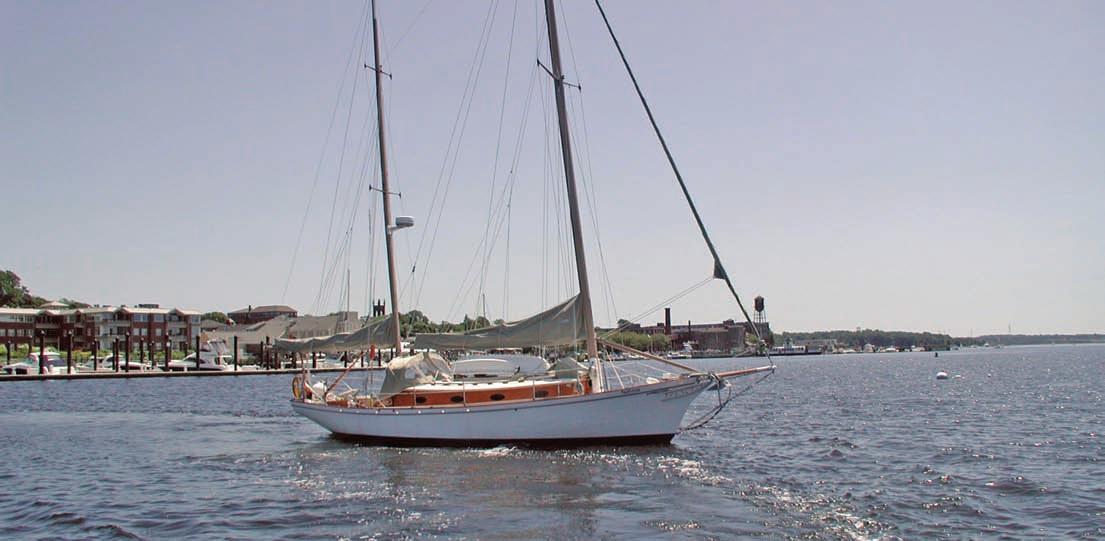
4 minute read
Talk of the Dock
Talk of the Dock By Zuzana Prochazka
9.9 hp Propane Outboard by Lehr
Advertisement
Ah, the outboard – a necessary but often maligned piece of equipment that, throughout the years, has been responsible for stinky air, scraped knuckles and sheens of spilt gasoline floating on the water. Those days may be in the past however, since now there are other options to power your tender.
Lehr has just introduced the third model in their award-winning propane outboard line. This engine has 9.9 horsepower, an electric start and the option for remote steering – in other words, you can put it on a center console dinghy with a wheel. The new motor comes with a 15” or 20” shaft and weighs in at just under 88 pounds which is five pounds heavier than a comparable gas engine.
Unlike its 2.5 and 5 hp siblings, the new 212 cc four-stroke motor is powered by a 10 or 20-pound propane tank that you put in the dink, not a onepound camping stove bottle that you plug directly into the engine. It can be a typical metal tank like you use for cooking aboard, or one of Lehr’s composite models that are ideal for the marine environment. With this bigger engine, Lehr now makes sense for a broader segment of the tender market that requires more power. The 9.9 burns approximately a gallon of propane per hour at wide open throttle (4,600 rpm) or about .44 gallons per hour (3,000 rpm). Depending on the size of the tank, your speed, and the sea and wind conditions, you’ll be able to run from five to 14 hours per tank.
Propane is cheaper than gas, burns cleaner, and doesn’t produce any emissions whether into the air or water. The patented fuel-metering system replaces the carburetor or fuel injection on gas-powered outboards. With Lehr’s pressurized system and no choke, starting is easier regardless of temperature. There are also no worries over winterizing, or storing your outboard when old fuel gums up the carburetor.
Depending on shaft length and options (with/ without electric start and tiller/remote steering) the price ranges from $2,600 to approximately $3,600 which varies by retailer. For more information, visit goleher.com.
Outboard Alternatives
Travel 1003 & Cruise T by Torqeedo
If you currently don’t carry propane, for example if you have a trawler with an electric cooktop and a large battery bank, then an electric outboard might make more sense. The disadvantages of an electric motor are charging time, expense and overall range/speed. The advantage is that it will be much quieter than either gas or propane-powered engines. Torqeedo made headlines a few years back with their Germanengineered electric models and over the years, they have grown and improved their offering.
The Travel 1003 is a waterproof (IP 67) electric motor that is roughly the equivalent of a 3 hp gas engine and can power a boat up to 1.5 tons. It weighs 31 pounds with the integrated lithium-ion battery and can be carried easily to and from your dinghy. It comes with either a long or short shaft and has an onboard computer that uses GPS to calculate your remaining range. At slow speed, half throttle and full throttle, the 1003 will run 10.5, 3.5 and .5 hours respectively, at speeds of two to five knots. From fully discharged, the charging time is 15 hours and you can just disconnect the battery and take it home to charge. You can also purchase a second battery and double your run time or buy Torqeedo’s proprietary solar panel that will charge even as the engine is running but it will set you back another $1,000 over the engine price of $1,999. The next step up is the Cruise T 2.0 (5 hp) and 4.0 (8 hp). The T stands for “tiller” but the Cruise is also available with a remote steering package as in the Cruise R. Depending on the horsepower, the T models use one or two batteries – either Torqeedo’s proprietary brand or AGMs. The 2.0 weighs just under 40 pounds while the 4.0 is one pound heavier. Of course, this doesn’t take into account the batteries which will need to be stored in the dinghy and can weigh in excess of 80 pounds.
The 2.0 will power a boat up to three tons at speeds of 1.5 to 6.5 knots for 2 to 110 hours depending on throttle. The 4.0 will power a boat up to four tons from 3 to 11 knots for 1 to 8 hours also depending on throttle. Pricing on the Cruise T ranges $3,299 - $3,849 depending on shaft length, horsepower and accessories.
Finally, Torqeedo also offers an 80 hp model that was just introduced at the Miami boat show. Unfortunately, this will not be a suitable model for dinghies because the batteries it needs would swamp your tender and the starting price is around $80,000 for the package. That said, it is kind of cool.
For more information, visit torqeedo.com.











